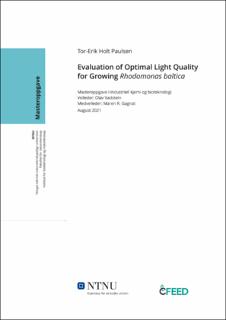| dc.contributor.advisor | Vadstein, Olav | |
| dc.contributor.advisor | Gagnat, Maren R. | |
| dc.contributor.author | Paulsen, Tor-Erik Holt | |
| dc.date.accessioned | 2021-10-14T17:19:49Z | |
| dc.date.available | 2021-10-14T17:19:49Z | |
| dc.date.issued | 2021 | |
| dc.identifier | no.ntnu:inspera:80861898:18195901 | |
| dc.identifier.uri | https://hdl.handle.net/11250/2823134 | |
| dc.description.abstract | Fototrof dyrking av mikroalger ved hjelp av kunstig belysning er en energikrevende prosess. For å forbredre prosessens økonomiske bærekraft bør den optimale lyskvaliteten benyttes. Med mål om å finne den kombinansjonen av monokrome lyskvaliteter som gav høyest maksimale vekstrate (µ-max ) for svelgflagellaten Rhodomonas baltica Karsten 1898, ble det brukt kombinasjoner av rødt (λ: 620-625 nm),
blått (λ: 465-467 nm) og grønt (λ: 465-467 nm) lys med en samlet fotonflukstetthet på 100 µmol/m²s. Forsøkene med ulike lykvaliteter benyttet en nylig publisert metode ved hjelp av en mikro-skala fotobioreaktor (PBR) kalt Nanocosm og 96-brønners brett (BB).
Denne studien har vist at R. baltica kan vokse med høy vekstrate (>0.90 d −1 ) under ulike sammensettninger av lys i et BB. Videre ble det funnet at en kombinasjon av 10-30% grønt og 90-70% rødt lys gav en 17-37% høyere µ max enn ved bruk av 100% rødt lys. Denne studien viste også at resultatene funnet i BB-skala var sammenliknbare med observasjonene gjort i liter-skala og derav underbygget at de var skalerbare. Ved å benytte ulike næringsmedier har denne studien bekreftet at næringsmangel hos R. baltica resulterer i redusert kvanteutbytte (QY) og at nitrogenbegrensning forutsaker en fargeendring som skyldes pigmentnedbrytning. I tillegg ble ulike metoder for måling av biomassetetteht og beregning av µ-max evaluert. | |
| dc.description.abstract | Phototrophic cultivation of microalgae using artificial light require large amounts of energy. In order to enhance economically feasibility, the production process needs to utilize optimal light qualities. With the aim of finding the combinations of monochrome light that gave the highest maximum specific growth rate (µ max ) for the cryptophyceae Rhodomonas baltica Karsten 1898, this study applied fractions of red (λ: 620-625 nm), green (λ: 522-525 nm) and blue (λ: 465-467 nm) light at a total photo flux density of 100 µmol/m 2 s. The light composition study was conducted using a recently published method that utilized a micro-scale photo
bioreactor (PBR) named Nanocosm and 96-well plates (WP). This study showed that R. baltica can grow at a high growth rate (> 0.90 d −1 ) using different light regimes in WPs. It was found that the use of 10-30% green and 90-70% red light gave a µ max 17-37% higher than 100% red light.
This study also found that the results at WP scale were comparable to observations at litre scale, thereby supporting the scalability. By using different nutrient media, this study confirmed that nutrient starvation of R. baltica reduced QY (quantum yield), and that nitrogen limitation cause color change related to pigment degradation. Finally, different methods of measuring biomass density and calculating µ max was evaluated. | |
| dc.language | eng | |
| dc.publisher | NTNU | |
| dc.title | Evaluation of Optimal Light Quality for Growing Rhodomonas baltica | |
| dc.type | Master thesis | |
